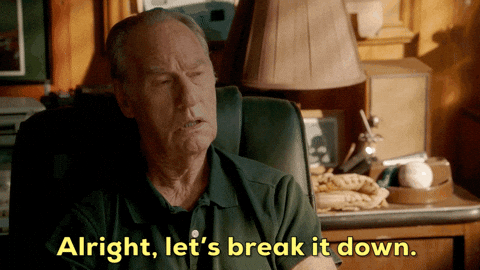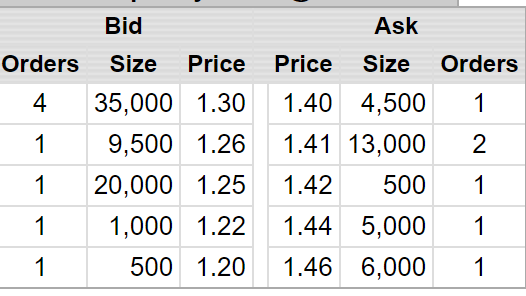- Fucked Finance
- Posts
- Weekly Lesson Wednesday - March 13th, 2024
Weekly Lesson Wednesday - March 13th, 2024
Lets get deep.
Weekly Lesson Wednesday📝
Let’s dive into the depth.

Lesson
Reading the Depth & Why it’s is important

Some of you can read Depth better than I can read the English language, but Weekly Lesson Wednesday is for the up and cummers, so we will dive into a very preliminary lesson on reading market depth.
Today we will specifically focus on the “Bid’ and the “Ask”. I am sure you see it all the time in your brokerage app. But what does it mean?
In Simple Terms:
Bid: The Bid price represents the highest price a buyer is willing to pay for a stock. Think of this literally like a bid at an auction for a stock. You put in an offer to buy a stock; if you put the offer in at the market price (the price people are willing to sell) of the stock, your bid will get accepted (like a buy-it-now price on ebay) and your trade will go through boom you own the stock, otherwise it remains on the bid as a “Bid” waiting for someone to go to that level and sell the stock. Like when you put an order in your brokerage account you’re waiting for it to get filled (pending, pending, pending), that is a real-life “Bid”! Your offer! sitting there waiting for someone to kindly sell their stock to your nickel and dime ass.
Ask: The Ask price represents the lowest price a seller is willing to accept for a stock. Think of it as the opposite of a bid: this is the lowest price someone is willing to sell their stock. Sitting there waiting for someone to buy the stock at that price. So if you own stock and don’t want to sell it for “Bid” price, which is the highest price there is stock available for you to sell at, your sell order - the order waiting to get filled remains on the “Ask”.
Ok if you are really smart and can understand the intricacies that come along with that cool, fuck you, took me a while, but now I am about to get really autistic, so buckle up.
Now, there isn’t just one “Bid” & “Ask” Every single sell order above-market buy price remains an “Ask” and every buy order below-market sale price remains an “Bid”.
The Bid & Ask stack up and create the market depth.
The ask is comprised of all the shareholders trying to sell
The bid is comprised of new or existing shareholders trying to acquire.
However, the highest Bid and lowest Ask create what we call the Bid-Ask spread, the difference between the buying price and the selling price of the stock.
Bid = Highest price the market will buy your stock off you for (sell price)
Ask = Lowest price the market has shares up for grabs for (buy price)
Could call it the spread “sell price-buy price spread”
You may have seen this funny Bid-Ask thingy with numbers below it like this👇

Bid-Ask spread = Bid 0.405 & Ask .42.
So what this means is, that the highest price someone is willing to pay for the stock now is 0.405 (Bid) and the lowest someone wants to sell it is (0.42). Even though the price of the stock shows as 0.405, if you wanted to gain instant ownership and buy the stock now, you would have to purchase at the Ask (.42) which is currently the lowest price someone is willing to get rid of their shares, and that transaction would now create a new price of the stock (0.42).
Quick lesson: A stock price is whatever price the last trade took place at.
So if you wanted to buy this stock now, you would have to pay the Ask price of .42, even though your silly little app says it is .405 (that’s yesterday’s news pal). Now when that trade goes through. It is now a 0.42 stock since that was the “last” price a trade transacted. Maybe it was one share at .42, doesn’t matter, till another order goes through at a new price, the price of the stock is always the last transaction. So be weary where that ask is… Don’t want to reach too far for it.
Don’t be alarmed, we can actually track all these Bid’s and Ask’s real-time, so we know exactly how many shares we can buy at what price, and how many shares we can sell at what price.
This is a common display of market depth and the bid & ask stack.

Here you can see the bid-ask would be $1.30-$1.40, you can see all the willing buyers’ Bids under the “Bid” and all the willing sellers asks under the “Ask” (highest willing buyer $1.30, the lowest willing seller $1.40 hence the $1.40-$1.40 bid-ask).
You can even see it by order. There are 4 bids to buy the stock for $1.30 for a total of 35,000 shares (we say there are 35,000 on the bid) & 1 order on the Ask wanting to sell for $1.40 for a total of 4,500 shares (4,500 shares on the ask)
So, if you bought 4,500 shares at $1.40, you would have cleared the Ask, now the next trade to go through would be at $1.41 (since you bought all the shares for sale at $1.40), causing the stock to go up. If people can buy the ask faster than it stacks, the stock moves up.
Supply and demand mother fucker.
The same on the downside, if people are selling into Bids faster than the the poor little buyers and keep their bids up, stock comes tumbling down.

The bid and ask sits there, but often traders and investors show up and don’t even make an offer. Fuck waiting to buy or sell right? So they just eagerly buy or sell at whatever the market will fill them at aka they hit the “bid’ or hit the “ask”, filling up other people’s outstanding orders (market order).
Or sometimes people panic to sell and wish to exit at all costs and not wait for someone to buy their shares on the Ask, so they start dumping their shares to the fellas on the bid, clearing all the offers off, crashing the stock price till they have no more shares for sale (if they have a sizeable position).
It goes both ways, when people/peoples are eager to get in, they buy stock off of the ask, which clears it up and helps push the ask higher and higher, causing the sales to be done at higher prices (more buying than selling) that is what creates a stock price to increase.
But when there is more selling than buying, and people are selling all their shares into the bid well there are no buyers or not enough buyers to fight them off, they will clear the bid and the stock price will keep falling till the sellers get exhausted and the bid can hold its ground.
Here is a confusing ass photo.

Influx of buyers = the ask gets bought out and moved to higher prices = stock increase
Influx of sellers = bid gets smashed down and moved to lower prices = stock decrease.
All quite confusing, but insanely important that you understand the Bid-Ask spread so we don’t accidentally market order and overpay for a stock. Some stocks have very big spreads due to no liquidity, the stock may say $0.10 on your Robinpoop App, but the lowest price there are shares for sale is $1, and you market order, and end up buying an illiquid piece of garbage for 10x then you thought you paid for it. Trust me it happens.
What is the Bid & Ask Made of?
Hopefully, we understand the concept of the Bid & Ask now, but more important than anything - how many shares represent them? If you want to take a trade, you need to know how many shares are available at your desired buy or sell price. Because the Bid-Ask may appear tight, for example, $1.00-$1.10, just because the ask is $1.10, it doesn’t mean you will get filled for $1.10. Maybe there are only 10 shares for sale at $1.10 and you go to buy 100 shares, okay you will get partially filled at $1.10 from the 10 shares on the ask, but maybe there are only 10 more shares for sale at $1.20 and 10 more for sale at $1.30 and then the last 70 shares were at $1.50, well my friend if that was a market order, you will pay up to $1.50 now to accumulate your 100 shares, throwing your original buy price out the window. So know how many shares the ask or bid is comprised of and buy and sell according to that, know how much you will buy or sell for by matching the order size to Bid/Ask size.
Thin Bids & Thins Ask’s
Personally, I love Thin Ass’s sorry… Thin Ask’s.
A thin Ask indicates low selling resistance and little buying could cause big upside movements.
A thin bid indicates no price support and little selling could cause big upside movements
The ask serves as price resistance.
The bid serves as price support.
A stock with nothing on the bid is risky, it wouldn’t take many pissed-off sellers to bury the stock.
We like to see stocks with stacked Bids and think Ask’s, which means it would take a lot of selling to damage the price, and it would take little buying to increase the price.
Once you understand the Bid and Ask to a certain level, you can nail price movements, you can almost exactly find resistance/support levels and hit very nice trades based on the Bid-Ask stack.
Also, a good company will always be on its own Bid, supporting its price, and supporting the shareholders.
A rotten company may have mad shareholders always on the Ask, the mad shareholders may sell into every bid or resist every order they can get for liquidity to exit the deal.
Stacked ask = no good
Stacked bid = cool shit
Bid-Ask To Be Continued.
I really tried my best to get it across, I hope you guys took something from this because it is a game changer. For me, I had no idea what the fucking Bid-Ask, Depth, this, that was for years, but when it clicked, it clicked hard, and the whole game made sense, it’s enabled me to trade and invest with a new level of confidence and be able to analyze small cap movements like that one 60-year-old uncle does to a barely legal Joeys waitress.
Education
Keen to learn more?
If you like these emails, the learning doesn’t end here….
Boy, do we have a fucking treat for you. We actually created a 2 day Master Class to take
you from absolute beginner to a God tier in these markets. We teach the nitty gritty, unorthodox, untold alpha that we learned working on the inside of these markets.
I’ll lay it out for you.

This course is for you if:
You are a beginner
You want to learn how to hit fucking banger trades and stack cash
Want to learn the in’s and out’s of how the game ACTUALLY WORKS
Want stock valuation and selection tools
This course isn’t for you if:
You don’t want to take the time to better your life (and bank account)
You want to trade options only
You are an experienced trader.
This is a beginner’s course that is designed to take you from 0-100. From an absolute noob to our level of knowledge and our secrets that we leverage to find sleeper stocks.
Cheers,
What did you think about today's newsletter?This helps us keep sending heat to your inbox... |